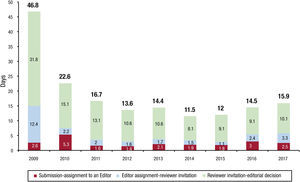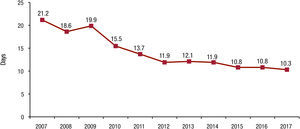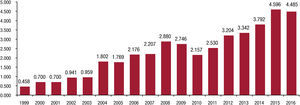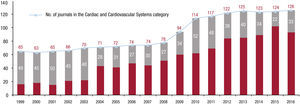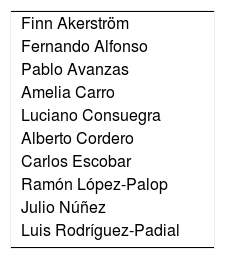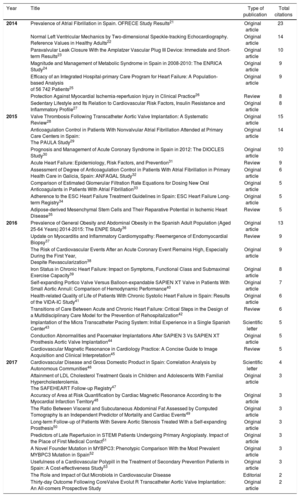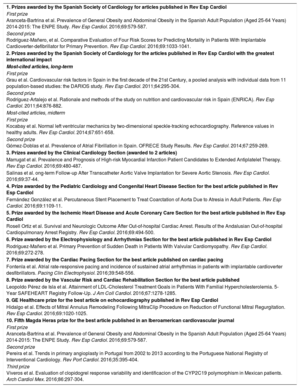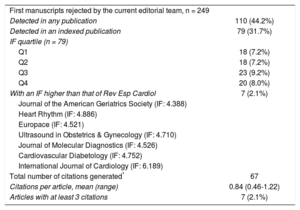This year marks the second of the current editorial team. In this “Editor's page”, the editorial team reviews the previous year of Revista Española de Cardiología (Rev Esp Cardiol) and reports its overall situation and future direction. The impact factor (IF) of 4.485 achieved in 2017 is similar to that obtained the previous year and thus consolidates the bibliometric success of the journal. In addition, we are proud to remain the leading Spanish and bilingual cardiovascular journal. This is perhaps why the demand for publication in Rev Esp Cardiol has increased, which has unfortunately resulted in a high rate of manuscript rejection. Aware of this situation, and prudently deciding to not increase the number of published articles in order to avoid excessive bibliometric fluctuations, this editorial team is considering a new publication envisioned as a secondary journal of Rev Esp Cardiol, with a marked clinical focus and with the aim of stimulating clinical research and academic publication among young cardiologists. In the pages that follow, we analyze the previous year of Rev Esp Cardiol and present our plans for the new journal project.
PUBLICATIONS OF REV ESP CARDIOL DURING 2017The total number of articles—specifically, “Original articles”, “Editorials”, “Scientific letters”, “Letters to the Editor”, and “Special articles”—published in Rev Esp Cardiol in 2017 vs previous years is shown in Figure 1. Although there was a slight fall in the number of articles, with a total of 312 vs 335 the previous year, there was an increase in the number of original articles and reviews, which are the two most defining elements of the scientific visibility of a journal. The drop in the number of published articles is primarily due to a lower submission rate for Letters to the Editor (44 fewer), in line with a slight decrease in the total publication demand, which was 1047 manuscripts vs 1160 in the previous year (Figure 2). This decrease also applies to original articles, whose submission rate fell slightly vs the previous year, although the journal still had the second highest demand for publication of original articles of all years (Figure 3).
As mentioned last year,1 reviews were published on a variety of topics deemed to be of particular interest by the editorial team. During the past year, 10 review articles were published, 3 on cardio-oncology,2–4 2 on advanced therapies for heart failure,5,6 1 on novel technological aspects in cardiology,7 1 on valvular heart diseases,8 1 on imaging,9 1 on cardiac amyloidosis,10 and 1 comprehensive review of biomedical research in the cardiovascular field.11 We wish to congratulate all of the authors for the quality of their work. Importantly, topics for review are usually selected toward the middle of the year in a meeting of the entire editorial team. Any author can propose a specific review topic by submitting an abstract of the review and its sections, with a summary of the authors’ experience in the field. At the meeting of the editorial team, if allowed by the space available for the editorial year, the most suitable reviews will be chosen from all of the proposals received.
One of the most significant quantitative changes has been in the number of scientific letters, which have increased from 74 in 2016 to 84 in 2017 (Figure 1). There are several reasons for this growth; the most important is the decision to increase the number of scientific letters per issue due to the stockpile that had been generated. It was also influenced by the change in the format of the annual updates coordinated by the different scientific sections of the Spanish Society of Cardiology (SEC). This series was published in previous years as special articles but they have been published as scientific letters since 2017 to reinforce their synthetic nature on the novelties of each scientific section. In 2017, 21 scientific letters were published with this format.
As noted last year,1 each issue includes two new sections: the section “Atrium”, which is a synthesis of the contents of each issue with the most salient features of the original articles and editorials published, and the section “Viaje al corazón de las palabras” (Into the heart of terminology), written by Fernando A. Navarro and very well received by our readers.
Regarding the digital version of Rev Esp Cardiol and its presence on social networks, the boost provided by the incorporation of José Juan Gomez de Diego in 2016 as an ICT Consultant continues to yield excellent results (Figure 4). We encourage readers who have not yet done so to follow the journal not only in its digital edition on the website12 and for tablets,13 but also on Twitter (@RevEspCardiol), Facebook14, and our blog.15 We also continue to have outstanding uptake of our Editor's pick.16 In these videos, via a face-to-face interview, an author of a featured article in each issue summarizes the essential concepts of the work and explains its significance.
Number of sessions on www.revespcardiol.org, overall and via social media, in 2016 and 2017.
Finally, since April 2017, access to all articles published ahead of print is free only for members of the SEC and subscribers to Rev Esp Cardiol. Elsevier has implemented this change to adapt our situation to that of other journals published by the group.
THE EDITORIAL PROCESSESFigure 5 shows the changes in the times required for the editorial process, specifically from when the authors submit the original version of their manuscript according to the guidelines of Rev Esp Cardiol until the first decision is made. The last year showed a slight increase of 1.4 days in the average processing time for the general editorial process. Although the time from manuscript submission to editor assignment has been slightly reduced, the other two phases have somewhat increased, particularly the time from editor assignment to article dispatch to the reviewer. This increase was, however, small and cannot be attributed to the learning curve of the new editorial team during this second year, and the tendency for the next year should be for a reduction. What continues to improve is the work performed by our reviewers (Figure 6), whom we would like to sincerely thank again. We would also like to convey our gratitude to all reviewers who collaborate with Rev Esp Cardiol despite not belonging to our Editorial Committee (Table 1). For the quantity, quality, and speed of their evaluations, the elite reviewers of 2017 also deserve special mention (Table 2).
Professionals Who Collaborated With Revista Española de Cardiología in 2017
| César Abelleira | José F. Díaz | Iñaki Lekuona | Jessica Roa |
| Alejandro Adsuar-Gómez | Ernesto Díaz-Infante | Pablo Loma-Osorio | Oriol Rodríguez |
| Arístides Alarcón | David Dobarro | M. Pilar López | Sergio Rodríguez de Leiras |
| Dimpna C. Albert | Fernando Domínguez | Lorenzo López Bescós | Ramón Rodríguez-Olivares |
| Manuel Almendro-Delia | Laura Domínguez | José R. López-Mínguez | José F. Rodríguez-Palomares |
| Ezequiel Álvarez | Sonia Eiras | Emilio Luengo-Fernández | Inmaculada Roldán |
| Ignacio J. Amat | Alberto Esteban | Alfonso Macías | José M. Rubín |
| Fernando Antoñanzas | Rodrigo Estevez-Loureiro | Nicolás Manito | Anna Sabaté |
| Javier Aranceta-Bartrina | Ángel L. Fernández | Begoña Manso | Rafael Salguero-Bodes |
| Ángel Aroca | Jaime Fernández de Bobadilla | Sergio Manzano-Fernández | Luisa Salido |
| Dabit Arzamendi | José A. Fernández Díaz | M. Dolores Marrodán | Pablo Salinas |
| Pablo Ávila | Nuria Fernández-Hidalgo | Gerard Martí | Marianela Sánchez Martínez |
| Enrique J. Balbacid | Queralt Ferrer | Efrén Martínez-Quintana | Damián Sánchez Quintana |
| José Banegas | Xacobe Flores | Victoria Martín-Yuste | Joan Sánchez-de Toledo |
| Jordi Bañeras | Ángela Flox | Mónica Masotti | Laura Sanchis |
| Joaquín Barba | Eduardo Franco | Pedro Mata | Marcelo Sanmartín |
| Joan A. Barbera | María Gallego | Ana Méndez | Melisa Santas-Álvarez |
| Eduardo Barge-Caballero | Carlos García Santos-Gallego | Irene Méndez | Gloria Santos-Beneit |
| Gonzalo Barón-Esquivias | Alberto García-Lledó | Antonio J. Muñoz-García | Ricardo Sanz-Ruiz |
| Vicente Barriales | Pablo García-Pavía | Luis Nombela-Franco | Inés Sayago |
| Vivencio Barrios | Juan C. García-Rubira | Raymundo Ocaranza-Sánchez | Fernando Soto |
| Teresa Bastante | Juan M. Gil-Jaurena | Soledad Ojeda | Javier Suárez de Lezo |
| Víctor Bazán | Antonio E. Gómez Mechero | Jordi Ordóñez-Llanos | Gisela Teixido-Tura |
| Begoña Benito | Josep Gómez-Lara | Domingo Orozco | Antonio Tello-Montoliu |
| José R. Berrazueta | Elvira González Obeso | Julián Palomino | Luis Teruel |
| Michele Biscuola | Álvaro González Rocafort | Pablo Pazos | Leire Unzué |
| Montserrat Bret | Antonio González-Calle | Pablo Peñafiel | José Á. Urbano-Moral |
| Naiara Calvo | Francisco González-Vílchez | Carlos Peña-Gil | Félix Valencia |
| Óscar Cano | Encarnación Gutiérrez | Esther Pérez-David | Israel Valverde |
| José A. Carbonell | Enrique Gutiérrez | Antonia Pijuan-Domènech | Beatriz Vaquerizo |
| Juan Caro-Codón | Federico Gutiérrez | Luis Pintor | Sonia Velasco |
| Fernando Carrasco-Chinchilla | Hipólito Gutiérrez | Francisco Portela | Maite Velázquez |
| Antonio J. Castro | Gabriela Guzmán-Martínez | Raquel Prieto | Ana Viana |
| Marinela Chaparro-Muñoz | Pilar Jiménez | Sergio Raposeiras | Rafael Vidal-Pérez |
| Isabel Coma-Canella | Santiago Jiménez | Vicenç Riambau | David Vivas |
| David Couto | Juan Jiménez-Jáimez | Elena Refoyo | Fernando Worner |
| José I. Cuende | Alfonso Jurado-Román | Montse Rigol | Esther Zorio |
| Irene Dégano | Pablo Lapunzina | Juan J. Ríos-Blanco |
Compared with previous years, the full incorporation of the new editorial process involving the serial management of the two versions (Spanish and English) has significantly reduced the time from manuscript acceptance to its electronic publication, at least its publication in the original submission language. The average time between acceptance and ahead of print publication in the language of submission for original articles is currently less than 7 weeks. The version in the complementary language takes about 11 to 12 additional weeks. Readers will recall that the new process involves rapid editing and publication of the version in the original language of submission, which allows the article in its original version to be made quickly available ahead of print and, therefore, in the bibliographic databases (eg, ScienceDirect), in addition to the Rev Esp Cardiol website.12 If the language of the original version is English, the article additionally becomes immediately available on PubMed. We would also like to take this opportunity to comment on a proposal that we have received, namely, encouraging Spanish as the initial language for manuscript submission. Undoubtedly, one of the strengths of Rev Esp Cardiol is its bilingual nature; we are very proud of this characteristic and believe that it boosts the presence of Spanish at the cutting edge of cardiovascular research. However, there are two indisputable facts: the language of scientific expression is English, and the scientific visibility of an article is directly related to the speed of publication after acceptance. Thus, precisely to improve the scientific visibility of their work, many Spanish-speaking authors have opted in recent years to submit their manuscripts directly in English. If accepted, these articles quickly appear on PubMed, encouraging their dissemination. Sometimes, these articles have been rejected by international journals publishing in English alone and are subsequently submitted to Rev Esp Cardiol. This requires an extra effort from our reviewers, most of whom are Spanish speakers, who often have to perform their work in English. Accordingly, that they continue to maintain excellent response times (Figure 6) is even more commendable.
Finally, a periodic review of the publication guidelines for Rev Esp Cardiol17 was performed in 2017 to ensure that they are kept up to date with international criteria18,19 and our own style standards. We have taken advantage of this opportunity to greatly expand the instructions to authors in order to facilitate the manuscript submission process and have included a new section on frequently asked questions.20
BIBLIOMETRIC ASPECTSThe IF of Rev Esp Cardiol was consolidated, although it fell very slightly vs the previous year. As readers undoubtedly know, the IF increases with a higher number of citations generated by articles in a journal and a lower number of citable items, specifically original articles and reviews, in the previous 2 years. In the latest version, the IF has declined very slightly, perhaps due to the increase in the number of citable articles, because the total number of citations (731) has increased vs the previous year (717). Moreover, the total number of external citations received is the highest in the entire history of Rev Esp Cardiol. Figure 7 shows the bibliometric evolution of Rev Esp Cardiol, which was placed in the second quartile of cardiovascular journals, in position 33 among a total of 126 journals, in the 2016 edition of Journal Citation Reports (JCR) (Figure 8).
As already shown in last year's “Editor's page”,1 we believe that it is important to know which of the research articles and reviews published in the journal have had the highest scientific dissemination and visibility in recent years. The publications of 2014 and 2015 influence the IF of JCR for 2016, while those published in 2015 and 2015 influence the IF for 2017; those published in 2017 influence the immediacy index, a reflection of the speed of the scientific visibility of a publication. Table 3 shows this information, extracted from the Web of Science from Clarivate Analytics56 at the start of 2018. We would like to warmly congratulate all of the authors of these articles. Finally, as in every year, we must mention and commend the authors of the publications that have received awards conferred by the SEC based on scientific impact and quality (Table 4).
Research Articles and Reviews Published in Revista Española de Cardiología in 2014, 2015, 2016 and 2017 Receiving the Most Citations up to December 2017
| Year | Title | Type of publication | Total citations |
|---|---|---|---|
| 2014 | Prevalence of Atrial Fibrillation in Spain. OFRECE Study Results21 | Original article | 23 |
| Normal Left Ventricular Mechanics by Two-dimensional Speckle-tracking Echocardiography. Reference Values in Healthy Adults22 | Original article | 14 | |
| Paravalvular Leak Closure With the Amplatzer Vascular Plug III Device: Immediate and Short-term Results23 | Original article | 10 | |
| Magnitude and Management of Metabolic Syndrome in Spain in 2008-2010: The ENRICA Study24 | Original article | 9 | |
| Efficacy of an Integrated Hospital-primary Care Program for Heart Failure: A Population-based Analysis of 56 742 Patients25 | Original article | 9 | |
| Protection Against Myocardial Ischemia-reperfusion Injury in Clinical Practice26 | Review | 8 | |
| Sedentary Lifestyle and Its Relation to Cardiovascular Risk Factors, Insulin Resistance and Inflammatory Profile27 | Original article | 8 | |
| 2015 | Valve Thrombosis Following Transcatheter Aortic Valve Implantation: A Systematic Review28 | Original article | 15 |
| Anticoagulation Control in Patients With Nonvalvular Atrial Fibrillation Attended at Primary Care Centers in Spain: The PAULA Study29 | Original article | 14 | |
| Prognosis and Management of Acute Coronary Syndrome in Spain in 2012: The DIOCLES Study30 | Original article | 10 | |
| Acute Heart Failure: Epidemiology, Risk Factors, and Prevention31 | Review | 9 | |
| Assessment of Degree of Anticoagulation Control in Patients With Atrial Fibrillation in Primary Health Care in Galicia, Spain: ANFAGAL Study32 | Original article | 6 | |
| Comparison of Estimated Glomerular Filtration Rate Equations for Dosing New Oral Anticoagulants in Patients With Atrial Fibrillation33 | Original article | 5 | |
| Adherence to the ESC Heart Failure Treatment Guidelines in Spain: ESC Heart Failure Long-term Registry34 | Original article | 5 | |
| Adipose-derived Mesenchymal Stem Cells and Their Reparative Potential in Ischemic Heart Disease35 | Review | 5 | |
| 2016 | Prevalence of General Obesity and Abdominal Obesity in the Spanish Adult Population (Aged 25-64 Years) 2014-2015: The ENPE Study36 | Original article | 13 |
| Update on Myocarditis and Inflammatory Cardiomyopathy: Reemergence of Endomyocardial Biopsy37 | Review | 9 | |
| The Risk of Cardiovascular Events After an Acute Coronary Event Remains High, Especially During the First Year, Despite Revascularization38 | Original article | 9 | |
| Iron Status in Chronic Heart Failure: Impact on Symptoms, Functional Class and Submaximal Exercise Capacity39 | Original article | 8 | |
| Self-expanding Portico Valve Versus Balloon-expandable SAPIEN XT Valve in Patients With Small Aortic Annuli: Comparison of Hemodynamic Performance40 | Original article | 7 | |
| Health-related Quality of Life of Patients With Chronic Systolic Heart Failure in Spain: Results of the VIDA-IC Study41 | Original article | 6 | |
| Transitions of Care Between Acute and Chronic Heart Failure: Critical Steps in the Design of a Multidisciplinary Care Model for the Prevention of Rehospitalization42 | Review | 6 | |
| Implantation of the Micra Transcatheter Pacing System: Initial Experience in a Single Spanish Center43 | Scientific letter | 5 | |
| Conduction Abnormalities and Pacemaker Implantations After SAPIEN 3 Vs SAPIEN XT Prosthesis Aortic Valve Implantation44 | Original article | 5 | |
| Cardiovascular Magnetic Resonance in Cardiology Practice: A Concise Guide to Image Acquisition and Clinical Interpretation45 | Review | 5 | |
| 2017 | Cardiovascular Disease and Gross Domestic Product in Spain: Correlation Analysis by Autonomous Communities46 | Scientific letter | 4 |
| Attainment of LDL Cholesterol Treatment Goals in Children and Adolescents With Familial Hypercholesterolemia. The SAFEHEART Follow-up Registry47 | Original article | 3 | |
| Accuracy of Area at Risk Quantification by Cardiac Magnetic Resonance According to the Myocardial Infarction Territory48 | Original article | 3 | |
| The Ratio Between Visceral and Subcutaneous Abdominal Fat Assessed by Computed Tomography Is an Independent Predictor of Mortality and Cardiac Events49 | Original article | 3 | |
| Long-term Follow-up of Patients With Severe Aortic Stenosis Treated With a Self-expanding Prosthesis50 | Original article | 3 | |
| Predictors of Late Reperfusion in STEMI Patients Undergoing Primary Angioplasty. Impact of the Place of First Medical Contact51 | Original article | 3 | |
| A Novel Founder Mutation in MYBPC3: Phenotypic Comparison With the Most Prevalent MYBPC3 Mutation in Spain52 | Original article | 3 | |
| Usefulness of a Cardiovascular Polypill in the Treatment of Secondary Prevention Patients in Spain: A Cost-effectiveness Study53 | Original article | 3 | |
| The Role and Impact of Gut Microbiota in Cardiovascular Disease | Editorial | 2 | |
| Thirty-day Outcome Following CoreValve Evolut R Transcatheter Aortic Valve Implantation: An All-comers Prospective Study | Original article | 2 |
Source: Clarivate Analytics Web of Science, 10 January 2018.56
Articles Receiving an Award From the Spanish Society of Cardiology in 2017
| 1. Prizes awarded by the Spanish Society of Cardiology for articles published in Rev Esp Cardiol |
| First prize Aranceta-Bartrina et al. Prevalence of General Obesity and Abdominal Obesity in the Spanish Adult Population (Aged 25-64 Years) 2014-2015: The ENPE Study. Rev Esp Cardiol. 2016;69:579-587. |
| Second prize Rodríguez-Mañero, et al. Comparative Evaluation of Four Risk Scores for Predicting Mortality in Patients With Implantable Cardioverter-defibrillator for Primary Prevention. Rev Esp Cardiol. 2016;69:1033-1041. |
| 2. Prizes awarded by the Spanish Society of Cardiology for the articles published in Rev Esp Cardiol with the greatest international impact |
| Most-cited articles, long-term |
| First prize Grau et al. Cardiovascular risk factors in Spain in the first decade of the 21st Century, a pooled analysis with individual data from 11 population-based studies: the DARIOS study. Rev Esp Cardiol. 2011;64:295-304. |
| Second prize Rodríguez-Artalejo et al. Rationale and methods of the study on nutrition and cardiovascular risk in Spain (ENRICA). Rev Esp Cardiol. 2011;64:876-882. |
| Most-cited articles, midterm |
| First prize Kocabay et al. Normal left ventricular mechanics by two-dimensional speckle-tracking echocardiography. Reference values in healthy adults. Rev Esp Cardiol. 2014;67:651-658. |
| Second prize Gómez-Doblas et al. Prevalence of Atrial Fibrillation in Spain. OFRECE Study Results. Rev Esp Cardiol. 2014;67:259-269. |
| 3. Prizes awarded by the Clinical Cardiology Section (awarded to 2 articles) |
| Marrugat et al. Prevalence and Prognosis of High-risk Myocardial Infarction Patient Candidates to Extended Antiplatelet Therapy. Rev Esp Cardiol. 2016;69:480-487. |
| Salinas et al. ong-term Follow-up After Transcatheter Aortic Valve Implantation for Severe Aortic Stenosis. Rev Esp Cardiol. 2016;69:37-44. |
| 4. Prize awarded by the Pediatric Cardiology and Congenital Heart Disease Section for the best article published in Rev Esp Cardiol |
| Fernández González et al. Percutaneous Stent Placement to Treat Coarctation of Aorta Due to Atresia in Adult Patients. Rev Esp Cardiol. 2016;69:1109-11. |
| 5. Prize awarded by the Ischemic Heart Disease and Acute Coronary Care Section for the best article published in Rev Esp Cardiol |
| Rosell Ortiz et al. Survival and Neurologic Outcome After Out-of-hospital Cardiac Arrest. Results of the Andalusian Out-of-hospital Cardiopulmonary Arrest Registry. Rev Esp Cardiol. 2016;69:494-500. |
| 6. Prize awarded by the Electrophysiology and Arrhythmias Section for the best article published in Rev Esp Cardiol |
| Rodríguez-Mañero et al. Primary Prevention of Sudden Death in Patients With Valvular Cardiomyopathy. Rev Esp Cardiol. 2016;69:272-278. |
| 7. Prize awarded by the Cardiac Pacing Section for the best article published on cardiac pacing |
| Fontenla et al. Atrial rate-responsive pacing and incidence of sustained atrial arrhythmias in patients with implantable cardioverter desfibrillators. Pacing Clin Electrophysiol. 2016;39:548-556. |
| 8. Prize awarded by the Vascular Risk and Cardiac Rehabilitation Section for the best article published |
| Leopoldo Pérez de Isla et al. Attainment of LDL-Cholesterol Treatment Goals in Patients With Familial Hypercholesterolemia. 5-Year SAFEHEART Registry Follow-Up. J Am Coll Cardiol. 2016;67:1278-1285. |
| 9. GE Healthcare prize for the best article on echocardiography published in Rev Esp Cardiol |
| Hidalgo et al. Effects of Mitral Annulus Remodeling Following MitraClip Procedure on Reduction of Functional Mitral Regurgitation. Rev Esp Cardiol. 2016;69:1020-1025. |
| 10. Fifth Magda Heras prize for the best article published in an Iberoamerican cardiovascular journal |
| First prize Aranceta-Bartrina et al. Prevalence of General Obesity and Abdominal Obesity in the Spanish Adult Population (Aged 25-64 Years) 2014-2015: The ENPE Study. Rev Esp Cardiol. 2016;69:579-587. |
| Second prize Pereira et al. Trends in primary angioplasty in Portugal from 2002 to 2013 according to the Portuguese National Registry of Interventional Cardiology. Rev Port Cardiol. 2016;35:395-404. |
| Third prize Viveros et al. Evaluation of clopidogrel response variability and identificacion of the CYP2C19 polymorphism in Mexican patients. Arch Cardiol Mex. 2016;86:297-304. |
In recent years, and in parallel with its increased international visibility, Rev Esp Cardiol has recorded a notable and growing demand for publication that cannot be satisfied with its current capacity. As an example, of the 1047 manuscripts received in 2017, Rev Esp Cardiol has so far rejected 686 (66%), with 22 manuscripts pending decision at the time of publishing this Editor's page.
To explore the final destination of the original manuscripts rejected by this editorial team, we searched the Web of Science56 for the first 249 manuscripts received for publication as original articles that were ultimately rejected (Table 5). Of these articles, 110 (44.2%) were found in this database, although only 79 (31.7%) were published in indexed journals, most with an IF lower than that of Rev Esp Cardiol. In fact, only 1 of them was finally published in a journal with an IF markedly higher than that of our journal (International Journal of Cardiology), whereas 6 were published in journals with a similar IF, although in the first quartile. Perhaps the most revealing statistic is that the 110 published articles generated only 67 citations, less than 1 per article, and only 7 generated more than 2 citations. Although careful interpretation of these data is required because the research was performed in a limited sample and by a single researcher, from our point of view, two conclusions may be drawn. The first is that, in general, the editorial team has shown good judgment in the selection of original manuscripts for the journal, because virtually none of the rejected articles generated a large number of citations after their publication in other journals. Moreover, most of the journals with a certain IF to which the rejected articles were submitted were quite specific journals, whose area of interest might lie outside that of the average reader of Rev Esp Cardiol. Secondly, and more importantly, there is a critical mass of original articles submitted to Rev Esp Cardiol that, although ultimately rejected, are of sufficient quality for dissemination to other publications.
Fate of the First 249 Manuscripts Rejected by the Current Editorial Team and the Number of Citations Generated
| First manuscripts rejected by the current editorial team, n = 249 | |
| Detected in any publication | 110 (44.2%) |
| Detected in an indexed publication | 79 (31.7%) |
| IF quartile (n = 79) | |
| Q1 | 18 (7.2%) |
| Q2 | 18 (7.2%) |
| Q3 | 23 (9.2%) |
| Q4 | 20 (8.0%) |
| With an IF higher than that of Rev Esp Cardiol | 7 (2.1%) |
| Journal of the American Geriatrics Society (IF: 4.388) | |
| Heart Rhythm (IF: 4.886) | |
| Europace (IF: 4.521) | |
| Ultrasound in Obstetrics & Gynecology (IF: 4.710) | |
| Journal of Molecular Diagnostics (IF: 4.526) | |
| Cardiovascular Diabetology (IF: 4.752) | |
| International Journal of Cardiology (IF: 6.189) | |
| Total number of citations generated* | 67 |
| Citations per article, mean (range) | 0.84 (0.46-1.22) |
| Articles with at least 3 citations | 7 (2.1%) |
IF, impact factor.
Although the logical strategies to decrease the rejection rate would be to increase the number of articles in each issue of Rev Esp Cardiol and/or increase their frequency, such strategies would lead to a short-term decrease in the IF. However, the most important and reasonable conclusion is that the average quality level of original articles and reviews could be undermined, which would also have an impact on bibliometrics and prestige.
Nonetheless, the editorial team of Rev Esp Cardiol believes that a good number of the rejected manuscripts could be of more than sufficient quality to constitute a secondary journal title and has thus explored the feasibility and characteristics of this editorial project. The team believes that there is sufficient volume to publish up to 4 issues a year of a second title including 5 original articles in each issue, noting that this would encompass only between 10% and 15% of the original articles rejected by Rev Esp Cardiol. In this context, in November 2017, the Executive Committee of the SEC approved the creation of a second title, also edited by Elsevier and under the guise of a secondary journal, which is scheduled to be launched in 2019. The objective is to develop a new preferably online-only journal with an initial run of 4 issues a year in Spanish, a format similar to that of Rev Esp Cardiol, an independent editorial team, and a similar but eminently clinical focus, favoring original clinical research involving patients, training reviews on clinical matters, and observations and clinical cases. We encourage readers of Rev Esp Cardiol to contribute to the success of the new title by submitting their experimental results, observations, and clinical cases. In addition, one of the objectives of this publication is to enhance academic publication and clinical research among young cardiologists. We are convinced that, with the talent and enthusiasm found in Spanish and Latin American cardiology, the new project will be a success.
CONCLUSIONSRev Esp Cardiol is the official scientific publication of the SEC and serves as one of its vehicles of expression. The preceding year has seen consolidation of the bibliometric impact of Rev Esp Cardiol and demand for publication, which has resulted in a high rejection rate. For this reason, a project is underway to develop a new publication as a “secondary journal” of Rev Esp Cardiol, which hopefully can see the light of day at the beginning of next year and help to give more visibility to Spanish clinical research and academic publication.
The Editors and the Editorial Director of Rev Esp Cardiol are grateful for the excellent work and continued efforts of Eva M. Cardenal, María González Nogal, and Helena Gómez-Lobo, essential for the daily work of the journal and fundamental to achieve a publication of excellence. In addition, these words serve as a farewell to Montse Valero, who has been our journal manager for 8 years and whom we would like to thank for her excellent work ethic and her dedication and attention to detail.
CONFLICTS OF INTEREST
None declared.
.




